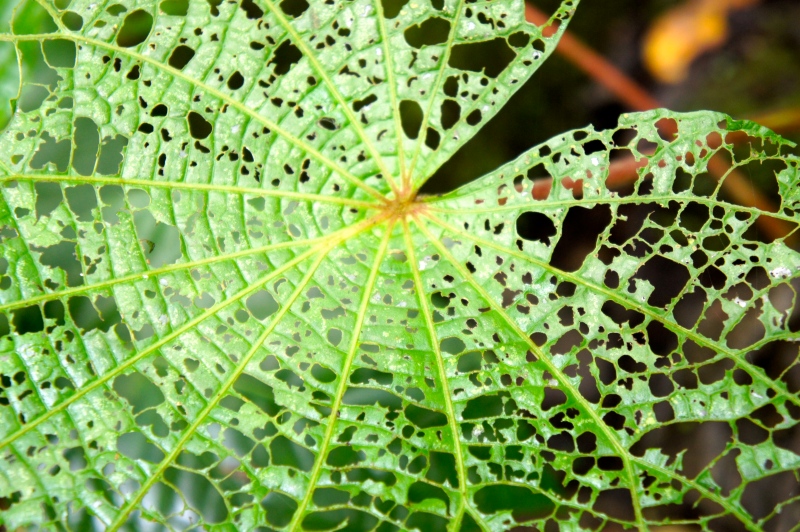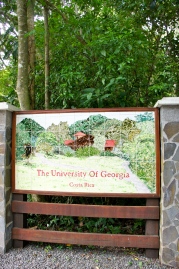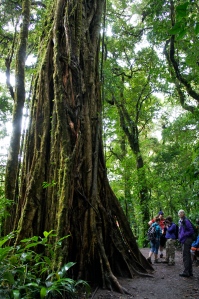When I was in college, I never knew how to reply to people who asked me what I wanted to be when I grew up. I thought about studying urban planning, architecture, optometry, law, or going into the foreign service but somehow ended up with a degree in English literature. But if I could do it all over again, after visiting the University of Georgia’s (UGA) campus in Monteverde, I would definitely add “naturalist” to that list.
What is a naturalist? In broad terms, it is a person who studies nature–the environment and its inhabitants. To me, a naturalist is also someone interested in educating not just him or herself but others as well about plants and wildlife. And in Costa Rica, with all the amazing flora and fauna around, it is natural (pun intended) to be surrounded by naturalists, from the average Tico with a menagerie in his back yard to the professionals who guide thousands of tourists each year through the forests wanting to see all that Costa Rica has to offer. In fact, here it is totally cool to “nerd out” on nature: getting up early to see the parrots grooming each other on the branches, staying up late hoping to see some peccaries or agoutis foraging for food, going on nature hikes to learn about all the epiphytes living in the cloud forest, and debating whether the bird you saw really was a blue-crowned mot mot while leafing through”The Birds of Costa Rica” reference guide.
One of the top qualities that a naturalist must possess is the power of observation. Animals and insects camouflage themselves carefully in order to avoid predators and to catch their prey. Thus, a naturalist must keep his or her ears and eyes wide open to notice whether that rustle in the tree is really the resplendent quetzal or just a false alarm. He or she notices the two-toed sloth up in the tree when the average tourist sees nothing. One of my favorite insects was the leaf katydid, which our naturalist guide pointed out on a night hike around the UGA campus. The leaf katydid is an insect that has the ability to change its coloring to imitate whatever the tree or branch it is on and it can imitate the tree so closely as to even have holes in its body to imitate the holes in the leaves. It’s really nothing short of amazing how much the professionals can spot.
Obviously, a keen eye for detail is also important. The naturalist must be able to distinguish between the various types of species of birds, reptiles, animals, plants, trees, etc. For example, there are over 50 types of hummingbirds in Costa Rica, so a naturalist has to determine whether what she sees is the common roufus-tailed hummingbird or perhaps the more exotic green-crowned brilliant or purplethroated mountain-gem. We saw at least 5 different species at the hummingbird garden right near the entrance to the Monteverde Cloudforest Preserve. I also loved hearing the guides whistling to the birds to find out where the birds were. On a night hike at Curi Cancha National Wildlife Refuge, our guide heard an owl but could not find it in the trees so he gave a couple of hoots and lo and behold, a curious mottled owl appeared to see what was going on. I am absolutely amazed by how much these naturalists can spot and remember.
While we were at the UGA campus, we were able to meet a couple of naturalist interns. One was Tess from Oakland, CA, who had studied geology and was now spending 6 months at UGA interning. She spent a few days with us telling us about the flora and fauna of the area and for someone who’d only been there for about 6 weeks, she already knew a ton. She told us that she picked up what she knew from going on lots of walks with other naturalists and guides, reading a lot, and going out and observing. FYI, naturalist internships are at UGA are 6 month stints with free room and board and duties include giving nature walks and introducing people like us to the surrounding flora and fauna. I only wish I had the time and a young, keen mind that could remember all the different names of all these different plants, reptiles, birds, and animals!
Although I will not be interning as a naturalist anytime soon, I am trying to practice the tools of the trade–careful observation, attention to detail, and learning from those who know around me. And as a result, we’ve been able to spot some pretty cool things–a tiny green glass tree frog hovered on a leaf, the blue-crowned mot mot on the side of the road, sea snails mating in a swirl of appendages, and so much more. It’s been a blast seeing all these new and unusual creatures and plants out here, and here’s to achieving junior naturalist status by the end of it all!



Marvelous! and as the scribbler knows…. drawing is one of the best ways to hone those observation skills 🙂
Absolutely! Another great reason to travel w/ an arteest!